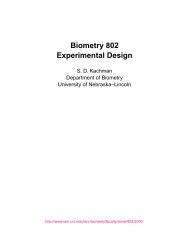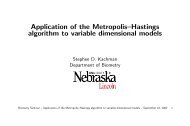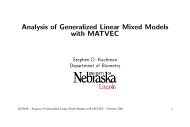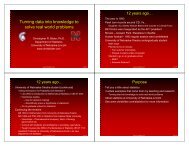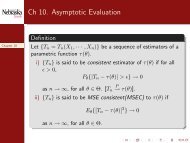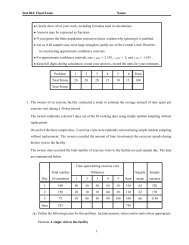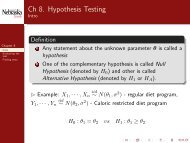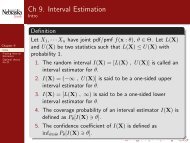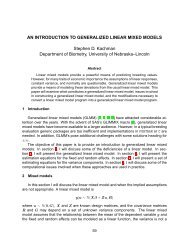Matvec Users’ Guide
Matvec Users' Guide
Matvec Users' Guide
- No tags were found...
You also want an ePaper? Increase the reach of your titles
YUMPU automatically turns print PDFs into web optimized ePapers that Google loves.
11.2. PENALIZED QUASI-LIKELIHOOD 79<br />
Table 11.6: Number of positive tubes out of 10 in a replicated dose response data.<br />
Formulation A<br />
Formulation B<br />
Replication<br />
Replication<br />
Log 2 Dose 1 2 3 4 5 1 2 3 4 5<br />
0 2 9 9 7 8 9 8 9 10 9<br />
1 2 6 8 8 10 7 7 8 8 9<br />
2 2 6 6 8 7 0 1 3 7 7<br />
3 1 3 1 6 6 0 2 0 1 1<br />
4 1 6 0 3 4 0 1 0 0 1<br />
5 0 7 2 1 4 0 0 0 0 0<br />
6 1 1 1 3 3 0 0 0 0 0<br />
Richards.equation("y=intercept,x=intercept,x=intercept,x=intercept");<br />
Init=Vector(700,7,.75,-1);<br />
Richards.init(Init);<br />
Richards.link("richards",1)<br />
Richards.variance("residual",identity(4,4)*1000);<br />
Richards.fitdata(D);<br />
Richards.glim(20)<br />
Richards.vce_aireml(40)<br />
K=identity(4,4);<br />
Richards.contrast(K)<br />
Richards.save("rat_ric.out")<br />
11.2 Penalized Quasi-Likelihood<br />
M.vce aireml() 1 estimates variance components based on the penalized quasi-likelihood function. Consider<br />
an experiment similar to the dose response experiment except that it has been replicated 5 times. The data<br />
are in Table 11.6.<br />
The linear predictor will include as fixed effects an intercept, a main effect for formulation, a covariate<br />
for log dose, and an interaction between formulation and log dose. Replication will be included as a random<br />
effect. Penalized quasi-likelihood estimates of the variance components are obtained using:<br />
D=Data();<br />
D.input("dose_r.dat","rep formul $ logdose n npos perc_pos");<br />
M=Model();<br />
M.equation("perc_pos=intercept formul logdose formul*logdose rep");<br />
M.covariate("logdose");<br />
M.weight("n");<br />
M.variance("rep",2);<br />
M.link("logit",0)<br />
M.fitdata(D);<br />
M.glim();<br />
M.vce_aireml(25,0);<br />
M.info("dose_r.info")<br />
M.vce aireml() takes up to two arguments. The first argument is the maximum number of iterations.<br />
The default number of iterations is 10. The second argument is the stopping criteria. By default the<br />
stopping criteria is to stop when residual log quasi-likelihood is changing by less than 1.e − 4 and will<br />
1 M.vce aireml() is only available for models that include a link function. However, M.link("normal",rvc) can be used to<br />
specify a linear mixed model.



